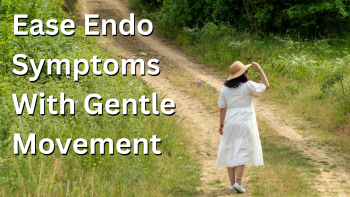You might be wondering why I'm dedicating an entire post to physical activity when my main expertise is nutrition. It’s a fair question. But the truth is: there’s strong scientific evidence that shows movement can help manage endometriosis symptoms — and that's something I can't ignore!
I’m not about to suggest you start running marathons or hitting the gym five times a week. Instead, I want to explain how physical activity impacts endometriosis, and give you simple, realistic ways to incorporate more movement into your life — all backed by research.
Why movement matters for Endometriosis
When managing endometriosis, it’s helpful to think of it like a buffet — you pick and choose different strategies that work best for your body. Nutrition is a big part of that, but it’s not the only tool. Movement is another powerful tool that can support all your other efforts, including diet.
Interestingly, research shows that women with endometriosis are generally less physically active than women without the condition. And honestly, that makes perfect sense:
- Fatigue can make even getting off the couch feel impossible.
- Pain often makes movement the last thing you want to do.
- Heavy bleeding and digestive symptoms (like diarrhea) can create practical barriers to exercising.
In short: it’s not laziness — it’s survival. But here’s the key: even small increases in movement can make a noticeable difference in how you feel.
The research on physical activity and Endometriosis
Here’s a summary of what studies have found:
- Movement might lower the risk (and maybe slow progression)
A 2004 study found that 4 hours of physical activity per week reduced the risk of developing endometriosis by 65%.
While this doesn’t tell us exactly what happens if you already have endometriosis, it suggests that regular movement might slow progression or reduce symptom severity. (Important to note: this was moderate to high-intensity exercise, like running and cycling.)
- Movement can help manage pain
Another important finding: physical activity on one day can reduce the perception of pain the next day.
Practically speaking, if you experience ovulation pain or period pain, increasing your movement a few days before could potentially make those pains feel less severe when they arrive.
If you track your cycle, you can plan gentle activity during the days leading up to your most painful phases.
- Movement helps tame chronic inflammation
Endometriosis is a chronic inflammatory disease. Movement has a complex relationship with inflammation:
- Moderate to high-intensity activity (think running, cycling, swimming) causes a temporary spike in inflammation during the activity — but this triggers an anti-inflammatory response afterward.
- Frequent moderate movement can lower chronic, low-grade inflammation, which is critical for managing endometriosis.
- Good muscle tone helps your body remove inflammatory cells more efficiently.
However, extreme or prolonged intense exercise (like marathon running) can actually increase overall inflammation — so balance is key. You don't need (and shouldn’t aim for) elite athlete-level intensity.
So, how much movement do you really need?
Consistency is more important than intensity.
You don’t need to exercise hard every day. Instead, focus on frequent, sustainable movement. Little bits of activity sprinkled throughout your day can have a big cumulative effect!
Here are simple, realistic ways to add more movement into your life:
- Take the stairs
- Start small: Take the stairs for one or two floors, then build up over time.
- Walking stairs strengthens your leg muscles (great for improving muscle tone) and gets your heart rate up (which boosts anti-inflammatory responses).
- Be Inefficient at home
- Instead of carrying everything upstairs in one trip, make multiple trips.
- Every extra flight of stairs is a mini workout that helps reduce inflammation.
- Active breaks
- During work breaks, take a short walk — even just around the block.
- If you work from home or at a desk, stand up and stretch regularly. Set a reminder if needed!
- Add movement to everyday tasks
- While brushing your teeth, stand on one leg to build balance and muscle tone.
- Do gentle squats while folding laundry.
- Try calf raises while washing dishes or cooking.
Even small movements activate muscles, improve circulation, and reduce inflammation over time.
- Rethink transportation
- If possible, park further away from work or errands.
- Get off public transport one stop early and walk the rest.
- Look for creative ways to add a few extra steps into your day.
Final thoughts: start small, but start
The goal isn’t perfection — it’s progress.
Adding just a little more movement into your day can help your body reduce inflammation, manage pain, and support all your nutritional efforts. Over time, these small changes can have a big impact on your endometriosis symptoms.
And remember: every little bit counts.
You don't need to "exercise" — you just need to move.
If you’d like to talk to me about other practical strategies to manage your Endometriosis symptoms, book a complimentary Endometriosis Discovery Call now: https://theendometriosisnutritionist.online/endometriosis-discovery-call/
